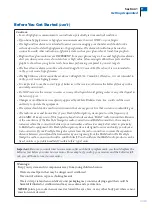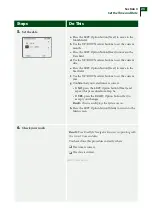
Helpful health related information:
The following pertain to your health and should always be kept in mind:
The system is intended to assist you in better managing your diabetes by allowing you to know your
•
glucose levels throughout the day.
Test results below 60 mg/dL (3.3 mmol/L) mean your glucose levels are low.
•
Test results above 240 mg/dL (13.3 mmol/L) mean your glucose levels are high.
•
Severe dehydration and excessive water loss may cause false low results. If you believe you are
•
experiencing severe dehydration, consult your healthcare team immediately.
If you get results below 60 mg/dL (3.3 mmol/L) or above 240 mg/dL (13.3 mmol/L) and do not have
•
symptoms of hypoglycemia or hyperglycemia, test your glucose using the Blood Glucose mode.
If you have symptoms of hypoglycemia or hyperglycemia, or continue to get results below 60 mg/dL
•
(3.3 mmol/L) or above 240 mg/dL (13.3 mmol/L), consult your healthcare team.
If you are experiencing symptoms that are not consistent with your glucose test results, consult your
•
healthcare team. Physiologic differences between the interstitial fluid and capillary blood may result
in differences in glucose measurements. Differences in glucose measurement between interstitial fluid
and your finger may be observed during times of rapid change in blood glucose, e.g. after eating, dosing
insulin, or exercising.
– Interstitial fluid (ISF) is the fluid between cells in the body. Movement of nutrients, oxygen
and glucose from the blood into the cells happen across the ISF. Therefore, if the glucose in the
bloodstream rises (e.g. during meals), that rise is not seen in the ISF until later. Similarly, if glucose
levels in the ISF drop (for example during exercise, the cells consume glucose rapidly) that drop is
not seen in the bloodstream until later.
When testing your glucose levels in the Blood Glucose mode, differences in the blood circulation in
•
your finger or palm (at the base of your thumb) and other test sites (forearm, upper arm, hand, thigh,
or calf) may result in different glucose readings. Differences in blood glucose readings between your
finger or palm (at the base of your thumb) and other test sites (forearm, upper arm, hand, thigh, or
calf) may be observed after eating, taking insulin, diabetes medication, or exercising.
Test your finger if you are testing for hypoglycemia or if you have hypoglycemia unawareness (see next
•
page for definition of hypoglycemia unawareness). Changes in glucose levels may be observed in finger
blood samples sooner than in samples from alternate sites (forearm, upper arm, hand, thigh, or calf). If
an alternate site must be used, vigorous rubbing of the alternate site before lancing can help minimize
this difference.
Do not use the FreeStyle Navigator system for diagnosing diabetes, testing newborns, or testing arterial
•
or venous blood.
Before You Get Started
(con’t)
If your results from the continuous monitoring mode do not reflect how you feel, test your glucose using
•
the Blood Glucose mode.
If you observe a significant change in your continuous glucose readings that you think is erroneous, or if
•
you feel the blood glucose measurement in the Blood Glucose mode is erroneous and you are close to an
electromagnetic interference source, move away from the source of interference and check to see if the
condition fades away.
If you have a medical appointment that includes X-ray, MRI (Magnetic Resonance Imaging),
•
CT (Computed Tomography) scan, or another type of exposure to radiation, keep your system and
sensor away from the area. Before exposure to such radiation, discard any sensor you are wearing and
insert a new sensor after the radiation session. The effect of these types of radiation on the performance
of the system has not been evaluated.
Customer Care: 1-866-597-5520
10
Section 1
Getting Acquainted
Summary of Contents for FREESTYLE NAVIGATOR
Page 2: ......
Page 4: ......
Page 8: ......
Page 9: ...1 Getting Acquainted ...
Page 23: ...2 Install or Replace Transmitter and Receiver Batteries ...
Page 29: ...3 Set the Time and Date ...
Page 34: ...Customer Care 1 866 597 5520 ...
Page 35: ...4 Perform a Control Solution Test ...
Page 42: ...Customer Care 1 866 597 5520 ...
Page 43: ...5 Insert or Remove Your Sensor ...
Page 54: ...Customer Care 1 866 597 5520 ...
Page 55: ...6 Attach Your Transmitter ...
Page 61: ...7 Calibrate Your System Test Blood Glucose Manually ...
Page 74: ...Customer Care 1 866 597 5520 ...
Page 75: ...8 Set Review or Change the Alarm Settings ...
Page 89: ...9 Daily Use ...
Page 96: ...Customer Care 1 866 597 5520 ...
Page 97: ...10 Respond to Alarms Errors and Problems ...
Page 119: ...11 Add Events ...
Page 125: ...12 Review Reports and Edit Events ...
Page 135: ...13 Clean Your System ...
Page 136: ...Section 13 Key Terms n Receiver n Transmitter n Contact Points Customer Care 1 866 597 5520 ...
Page 139: ...14 Link and Unlink Your Transmitter and Receiver ...
Page 144: ...Customer Care 1 866 597 5520 ...
Page 145: ...15 Reset User Settings ...
Page 146: ...Customer Care 1 866 597 5520 ...
Page 149: ...16 Change Country Settings ...
Page 155: ...17 Appendix A Site Maintenance ...
Page 158: ...Customer Care 1 866 597 5520 ...
Page 159: ...18 Appendix B Specifications ...
Page 173: ...19 Appendix C FCC Compliance Information ...
Page 174: ...Customer Care 1 866 597 5520 164 Section 18 Appendix B Specifications ...
Page 182: ...Customer Care 1 866 597 5520 ...
Page 183: ...20 Glossary ...
Page 184: ...Customer Care 1 866 597 5520 174 Section 19 Appendix C Classification Compliance Declaration ...
Page 191: ...21 Index ...
Page 192: ...Customer Care 1 866 597 5520 ...
Page 195: ......











































